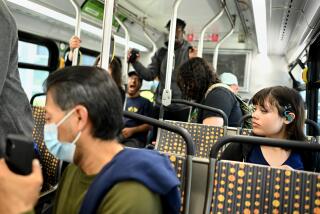Backyard Car Mechanic Is Fading : Newfangled Computer Systems Require Greater Skills
- Share via
A moment of silence, please, for the shade-tree mechanic who passed away recently after a lengthy illness.
The deceased was a victim of emission controls and computerized engines, and his demise is altering the auto parts and car repair industries.
With more cars than any other metropolitan area in the nation, the Orange County-Los Angeles basin was the first to mourn the passing.
But it also is the first to see the automotive future, which will include even more sophisticated repair equipment, greater reliance on rebuilt parts and a continuing shortage of qualified automotive mechanics--more properly called technicians in today’s high-tech garages.
Automobile engines have become increasingly complex in the last decade, according to Bob Medders, general manager of Auto Master Inc. of Santa Ana, an engine rebuilder. The sophisticated machinery and equipment required for many repairs, the tighter tolerances and greater demand for precision in newer cars have meant that car owners in growing numbers have turned repairs over to garages, both dealer-owned and independents.
“A lot of new cars have computer brains--you have to go to school for six months to learn how to repair them,” said Bret Clawson, manager of Dealers Automotive Warehouse Inc. in Anaheim, a supplier of parts to car dealers, independent garages and retail shops.
More Complexity Today
“When I was younger, a lot of people did a lot of their own work, but you didn’t need the kind of equipment you need today. There’s a lot more complexity in cars today,” said John Borie, a vice president at Wynn’s International Inc.--a Fullerton company that makes auto accessories and engine oil, coolant and fuel additives that Borie said are intended “to keep the old bucket running.”
More people are keeping the old car running longer, but the days when car owners did their own tuneups under a backyard shade tree on a Saturday afternoon are being relegated to history, the experts contend.
The complexity of automobiles today means car owners are turning to repair shops that rely on computers to check engine systems and take readings from the often-numerous, on-board computers.
“About the only thing a layman can do from about 1980 (cars) onward is the oil change,” said Daryl Thompson, service manager at Guaranty Chevrolet in Santa Ana. “Just to run a smog machine takes 60 hours of training.”
Everybody in the professional auto-repair business is busier now, according to Bill Sobrito, service manager at Theodore Robins Ford in Costa Mesa. Some modern repair procedures have become so specialized and complex that “I don’t understand half of them myself,” he said.
The demise of both the backyard mechanic and the all-around wrench turner at the corner service station prompted a surge of growth in independent and chain-owned car repair shops in the late 1970s and 1980s, industry officials said.
But the growing expense of specialized, sophisticated diagnostic equipment ultimately will squeeze out the independents, experts say, because only the dealer shops will be able to afford the equipment necessary to trouble-shoot the family car.
For example, an ignition-test monitor comes equipped with a $600 price tag, Sobrito said.
“The higher degree of technology . . . the diagnostic equipment expense . . . will tie car repairs to manufacturers,” said Dave Power, president of J.D. Power & Associates, a Westlake Village-based automobile industry consultant. “There is a bit of growth left for independents, but the trend is with the dealers.”
Staking Out a Niche
Tim O’Brien, however, believes that there still is room for independent repair shops, if they stake out a proper niche.
O’Brien, executive vice president and co-founder of Newport Beach-based Econo Lube n’ Tune Inc., said his company has been growing steadily over its 13-year history by keeping it simple, adding: “Our services are on the lower end of the spectrum.” And O’Brien anticipates continued growth. The company, which does oil changes, engine tuning and other relatively minor procedures, has 66 shops, all but two of them in Southern California, and has another 40 shops in various stages of planning or construction.
Both manufacturer-affiliated repair shops and independents have to cope with the chronic problem of recruiting enough skilled technicians, Power said. Like nearly everyone else connected with the auto industry, Power has stricken “mechanic” from his vocabulary in favor of “technician.”
“Mechanic” seems to call to mind a grimy-handed fellow with a rag hanging out of his pocket, Power said, and many of today’s technicians actually do more computer-operating than wrench turning.
But the disappearance of the shade-tree mechanic has been a mixed blessing for dealers and repair shops.
Shortage of Personnel
Although the industry is “going full tilt” in training and education, there is a severe shortage of mechanics, said William Wade, executive vice president of the Automotive Aftermarket News, a Chicago-based publication that circulates to 80,000 wholesale car parts distributors.
“Young people apparently are not taking to it as in generations past,” he said.
That could mean trouble in Orange County, where more mechanics will be needed to service an ever-growing number of cars. According to figures compiled by the state Employment Development Department, Orange County had an estimated 5,974 auto mechanics in 1980; there are expected to be 7,654 jobs for mechanics in 1990, a gain of 28%.
Assuring a supply of trained technicians has created a “grow-your-own situation” for many dealer shops, said Thompson, Guaranty Chevrolet’s service manager. As a partner in training programs with local high schools, Guaranty hires high school seniors on a part-time basis and gives them increased training when they graduate and go to work full time. Without the high school ties, Guaranty “absolutely would have been devastated by this time,” Thompson said.
The increasingly complex and expensive auto components also have spawned a growth industry in rebuilt parts.
$45-Billion Industry
The auto parts business is a $45-billion industry, said an executive with J.C. Whitney, the Chicago-based car parts giant.
Because of the sharply increased costs for auto components, rebuilding auto parts and systems has been growing at an “astronomical” rate, Wade said.
About 12% of Beverly Hills-based Cardis Corp.’s business for example, is in remanufactured parts. Cardis, which has its main computer operations and one of its central warehouses in Buena Park, is the largest distributor of auto parts in California and the third largest in the nation.
“As parts became more expensive in the last five years, people would put in a rebuilt carb instead of a new one,” explained Jack Salzberg, chairman and chief executive of Cardis, a corporate name formed by combining the words “car” and “distribution.”
And because of the growing sophistication required to restore a car’s health, Cardis sells a growing proportion of its new and used parts to car repair shops.
Growth in the use of rebuilt parts has created new jobs and resulted in a “tremendous” energy savings, Wade said, because the energy required to rebuild a part is often substantially less than that required to forge a new one.
But as cars become more like appliances, with sealed, modular components, rebuilding is likely to decline, too, Power said.






